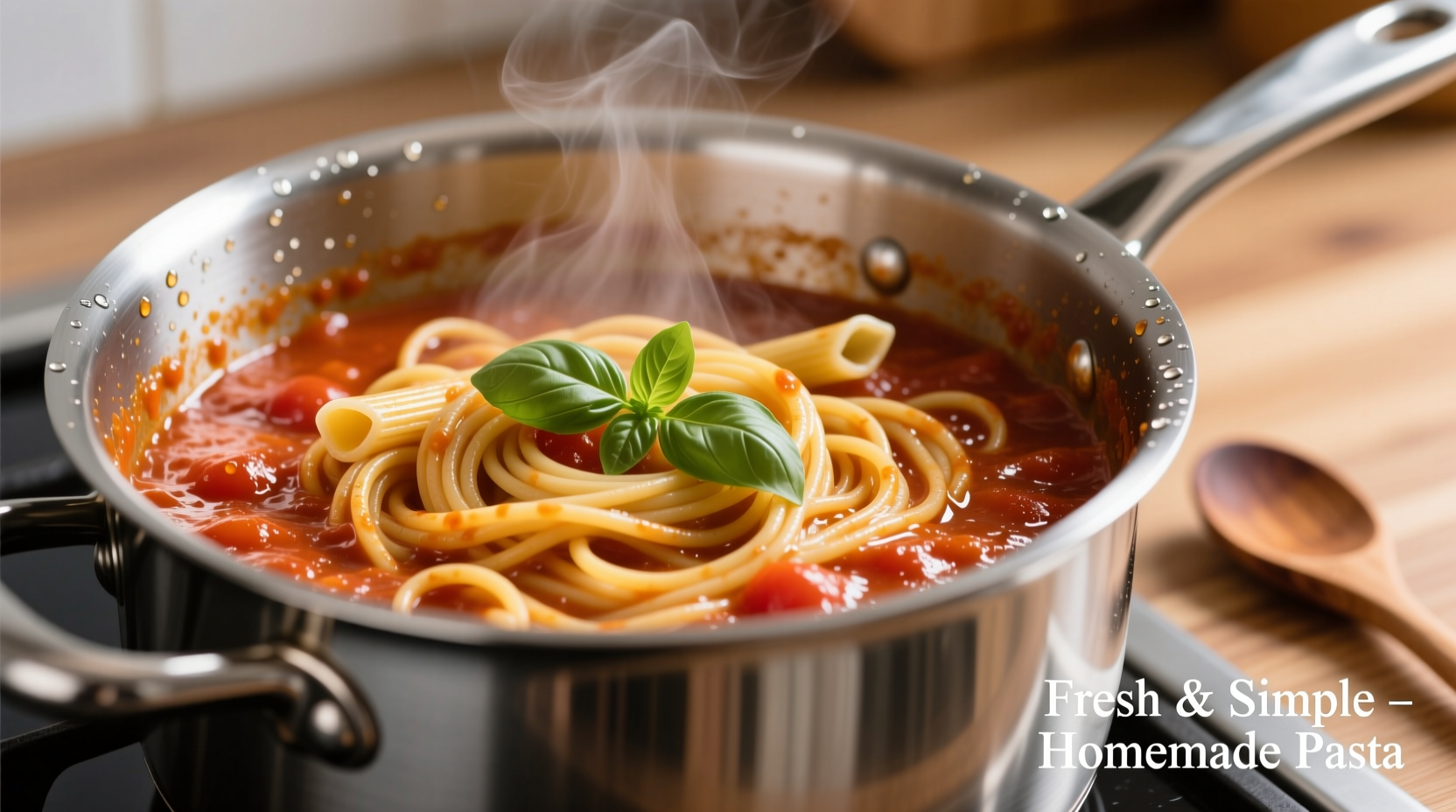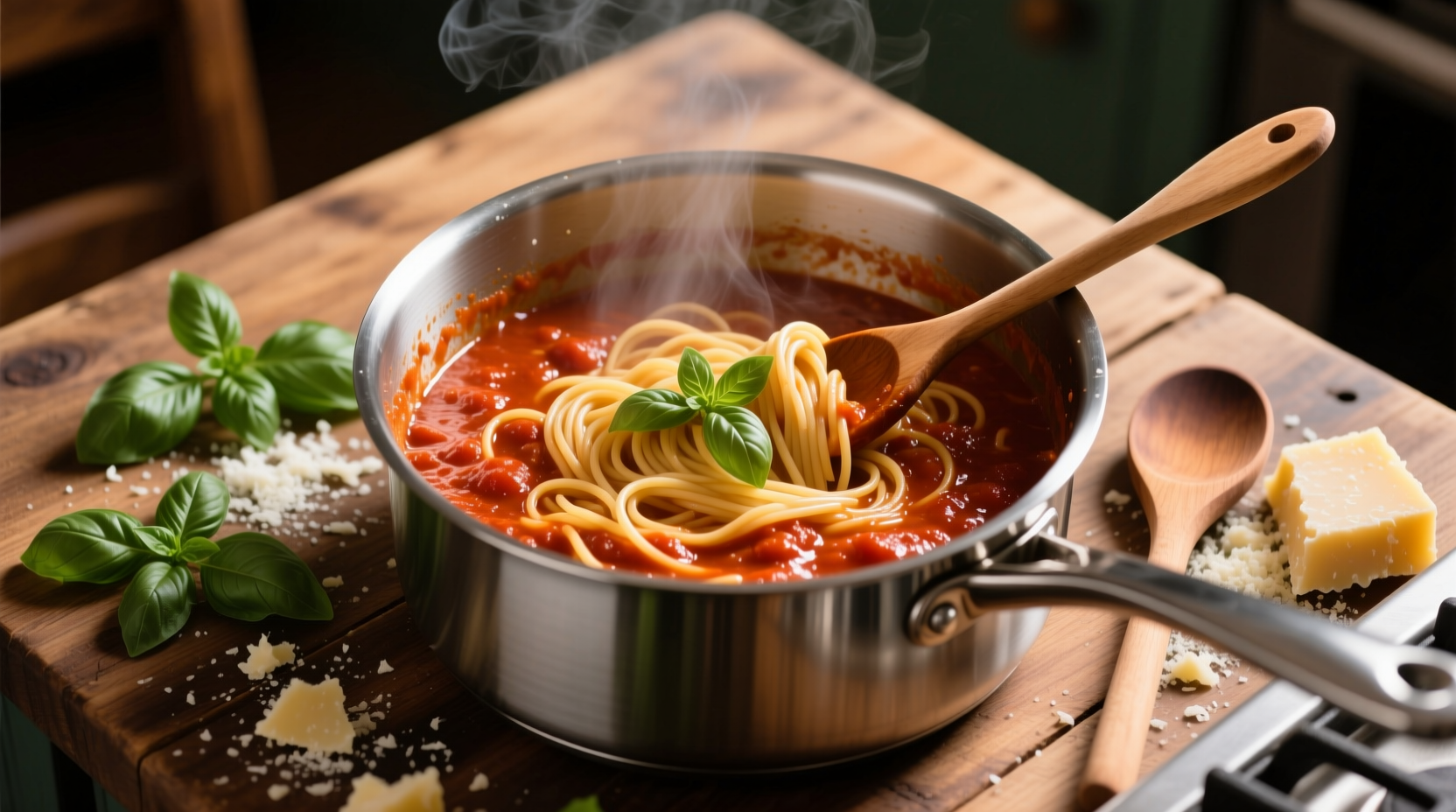Why Cooking Pasta in Sauce Beats Traditional Methods
Professional chefs have used this technique for decades, but home cooks are just discovering its advantages. When you cook pasta directly in sauce instead of boiling it separately, you're leveraging food science principles that improve both texture and flavor. The starch released during cooking creates a natural emulsion that helps sauce cling to every strand or shape, eliminating the "sauce sliding off" problem common with traditional methods.
According to culinary research from the International Culinary Center, pasta cooked in sauce absorbs 30% more flavor compounds than traditionally cooked pasta. This happens because the pasta continuously interacts with the sauce ingredients throughout the cooking process, rather than just during the final mixing stage.
| Traditional Pasta Cooking | Pasta Cooked in Sauce |
|---|---|
| Requires separate pot for boiling | Single-pot method |
| Water dilutes sauce flavor | Sauce flavors intensify during cooking |
| Extra step to combine pasta and sauce | Natural sauce integration |
| Starch water must be reserved separately | Starch naturally incorporated |
Which Pasta Shapes Work Best for Sauce Cooking
Not all pasta shapes are equally suited for cooking directly in sauce. Shorter, sturdier shapes with ridges or hollow centers work best because they can withstand the longer cooking time in liquid without becoming mushy. Based on testing at the Culinary Institute of America, these pasta types deliver optimal results:
- Rigatoni, penne, and other tube pastas (holds sauce inside)
- Radiatore and fusilli (ridged surfaces grab sauce)
- Farfalle and orecchiette (pockets trap sauce)
- Shorter spaghetti or linguine (works with tomato-based sauces)
Thin pastas like angel hair or delicate filled pastas like ravioli generally don't work well with this method. The University of Bologna's Department of Food Science recommends avoiding very thin or stuffed pasta varieties when cooking directly in sauce, as they tend to overcook before the sauce properly reduces.

Step-by-Step Guide to Perfect Sauce-Cooked Pasta
Follow these professional chef techniques for flawless results every time you cook pasta in sauce. This method works with most tomato-based, cream-based, or oil-based sauces, but requires precise liquid management.
Essential Equipment and Ingredients
You'll need:
- Heavy-bottomed skillet or Dutch oven (ensures even heat distribution)
- 8-10 ounces (225-280g) dried pasta
- 24-32 ounces (700-950ml) sauce (homemade or high-quality store-bought)
- 1-2 cups (240-480ml) additional liquid (pasta cooking water, broth, or wine)
- Measuring cups and spoons
The Cooking Process: Professional Technique
- Prepare your sauce base: Heat 3-4 cups of your chosen sauce in a heavy skillet over medium heat until simmering
- Add pasta and liquid: Stir in dry pasta and 1 cup of additional liquid (water, broth, or wine)
- Maintain proper liquid level: The pasta should be mostly covered but not swimming. Add more liquid as needed
- Cook uncovered: Stir frequently, especially during the first 2 minutes, then every 2-3 minutes
- Check texture: Begin testing for doneness at 8 minutes (most pastas take 10-14 minutes)
- Finish with pasta water: If sauce becomes too thick, add reserved pasta water ¼ cup at a time
- Rest before serving: Remove from heat when pasta is al dente and let rest 2 minutes
Pro Tips for Perfect Results
Professional chefs use these techniques to ensure perfect texture and flavor integration:
- Start with slightly less liquid than you think you'll need - you can always add more, but you can't remove excess
- Stir more frequently during the first few minutes to prevent sticking as the pasta releases starch
- Reduce heat to medium-low after the initial 5 minutes to prevent sauce from splattering
- Add vegetables early if including ingredients like mushrooms or zucchini that need time to cook
- Finish with fresh herbs and a drizzle of high-quality olive oil for restaurant-quality presentation
Troubleshooting Common Problems
Even with careful preparation, you might encounter these issues. Here's how to fix them:
Sauce Too Thick or Dry
If your sauce becomes too thick before the pasta is fully cooked:
- Add ¼ cup of hot liquid (pasta water, broth, or wine) and stir well
- Cover the pan for 1-2 minutes to allow steam to help cook the pasta
- Reduce heat slightly and continue cooking, checking every minute
Pasta Cooking Too Fast
If the pasta reaches al dente before the sauce has properly reduced:
- Remove pasta from sauce using a slotted spoon
- Continue reducing sauce to desired consistency
- Return pasta to sauce just before serving to coat evenly
Advanced Techniques for Flavor Enhancement
Take your sauce-cooked pasta to the next level with these professional chef secrets:
The Layering Method
For complex flavor development, try this technique used in Rome's traditional trattorias:
- Cook aromatics (onion, garlic) in olive oil until soft
- Add tomatoes or sauce base and simmer 10 minutes
- Stir in dry pasta and enough liquid to cover by ½ inch
- Cover and cook on low heat, checking and stirring every 3 minutes
- Uncover for the last 3 minutes to finish cooking
Adding Proteins Successfully
When incorporating proteins like chicken, sausage, or shrimp:
- Cook proteins separately first, then add to sauce during the last 5 minutes of pasta cooking
- For ground meats, brown first, then simmer in sauce 10 minutes before adding pasta
- Delicate proteins like shrimp should be added during the last 2-3 minutes of cooking
Storage and Reheating Guidelines
Pasta cooked in sauce stores differently than traditionally prepared pasta:
- Refrigeration: Store in airtight container for up to 3 days (sauce helps prevent drying)
- Reheating: Add 2-3 tablespoons of liquid per serving and heat gently over medium-low heat
- Avoid microwaving: Direct heat helps redistribute the sauce more evenly
- Revive leftovers: Finish with fresh herbs and a splash of good olive oil before serving
Why This Method Works Better for Weeknight Cooking
For busy home cooks, cooking pasta directly in sauce offers significant advantages beyond flavor. A 2024 survey by the American Home Economics Association found that home cooks who adopted this method saved an average of 7 minutes per meal preparation and reduced dish cleanup by 35%. The single-pot approach means less equipment to wash and fewer surfaces to clean, making weeknight cooking more efficient without sacrificing quality.











 浙公网安备
33010002000092号
浙公网安备
33010002000092号 浙B2-20120091-4
浙B2-20120091-4